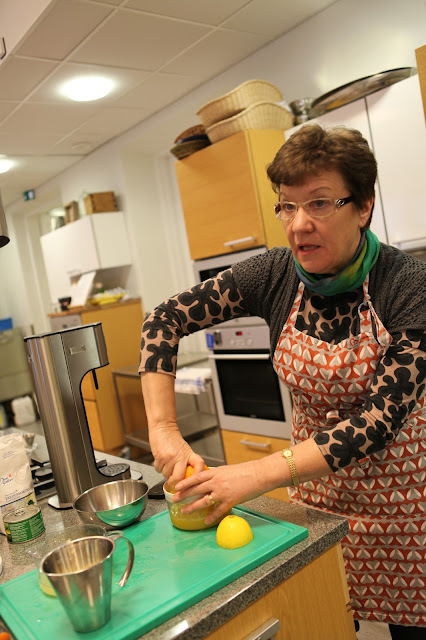To any Finn who visits me at my school in the United States, I promise to buy you coffee and a school lunch. I owe you. Any educating Finn. I am so enjoying the compelling conversations we are having and they're almost always accompanied by hot coffee, milk and sometimes a school lunch. Someone paid for this food and drink; I have to fill out a piece of paper for the accounting office - but I am almost never allowed to pay the price myself. Kiitos - for the sustenance and the conversations!
For those of you who don't already know, every Finnish child gets a "free" school lunch - at a total price to the Finnish people of about 4 euros per child per day, including labor. Here's a sample meal from my day at Aurora koulu (primary school):
Spinach cakes, lingonberries (I think they're lingonberries - they taste a bit like cranberries), mashed potatoes and cabbage salad. A glass of milk. Everyone here, even adults, seems to drink milk...and when I said to a Finn, "Most American adults don't seem to drink milk like Finnish adults do," his response was, "Yes, but they drink soda, don't they?"
Hmm... good point.
The U.S. may not have free lunches for all students but Finnish classrooms look very similar to American classrooms, albeit far less students, and the students they do have are far better behaved. There are marked differences in what is occurring in the classrooms, however, and this isn't revealed until one has long conversations with the teachers and students.
The conversations are priceless, and they are almost always accompanied by coffee and/or lunch.
I should include, however, that when I see great teaching in Finland it is comparable to the great teaching I've seen in the U.S. Both countries have great teachers (and not-so-treat teachers) and the Finnish teachers who have visited the U.S. tell me, "U.S. teachers work much harder than Finnish teachers!" It's true! U.S. teachers work so hard - so what is the problem? For one thing, U.S. teachers have many more students in our classrooms - I taught about 170 students/day before I left in December and a typical Finnish teacher might have 40-80 max; we also have far more content we're mandated to teach. Try talking to an American teacher at the end of the day - you won't get much conversation. They have nothing left to give because they've had to push their students so hard to get their content covered...and handle the discipline problems along the way.
But there is a lot of hope.
We should all be asking, "If U.S. teachers are working so hard, and we have great teachers (and not-so-great teachers) just like Finland, what are we doing wrong?

Part of Finnish success is their inherent desire to have discussions that include countering points of view. Personally, I have found very few times in American education where successful teachers are included as a meaningful part of the educational policy decisions. Crazy, I know. Teachers are included in the process but their opinions are oftentimes dismissed. Why? I think it's partly because everyone has been to school so they think they know what teachers should be doing. The problem is, being a teacher is very different than pretending you're a teacher. Leading a classroom is very different than making decisions for the people who have to actually manage the dynamics of that classroom. In my conversations in Finland, there is a different culture around education, educational policy, and how to build successful schools for their children - they listen - and act on - the input of their teachers. Finns want critical analysis, not just window dressing by saying that teachers are part of the committee. I have found that if I don't give my Finnish colleague or friend both sides of a situation, they will ask me for it. I LOVE THIS! It makes for much more interesting interactions. When I first arrived in Joensuu a colleague was quite frustrated with me because when he asked me about my school visits I was pleased with my visits... every time... and I told him so. His response was, "Quit being so American! Not everything is good! Tell me what isn't good!"
That made me think.
As Americans, we do that, don't we? Many of us let emotions take us over, we're afraid to cause conflict in our personal interactions, and we oftentimes generalize our opinions. Well, I've learned my lesson and every time I find myself generalizing my observations I stop myself and say, "Excuse me, let me try again." Then I add detail: "What I found interesting was ..... What didn't work well was .... Something new to me was...."
I interviewed Tiina Tahka from the Finnish National Board of Education and she told me that Finns want to hear what is working and what is not working so if they need to fix something, they can. I wonder if this approach is true in fields other than education; I know as American workers we're sometimes hesitant to say what isn't working to our bosses because they may not like it. Or think we're judging them. (That would be bad.)

When I visited Timo Takko and his 6th grade class, his students were debating the pros and cons of energy resources - and he told me he wanted to make sure his students had a point of view... and they did! I was quite impressed with the students' confidence in "arguing" their opinions, and when I interviewed these 6th graders on video they talked to me in English. In English! Sure, they helped each other a bit with uncommon words and grammar, but overall, they communicated their thoughts in a meaningful manner - and English is their second or third language. (They also study Swedish.)
The video interviews I'm collecting are more like discussions over a cup of coffee and I'm looking forward to sharing this compiled story with you. I hope it will will help you see why the Finnish system is working better than ours. At this point I have interviews from the following stakeholders:
Primary students
Lower secondary students
Upper secondary students
Primary teachers
Lower secondary teachers
Upper secondary teachers
Headmasters
Student teachers
University professionals
Finnish National Board of Education
I will give you different points of view as I take you through this trip through schools ...respectfully addressing the good and the not-so-good from my point of view - because I wouldn't be respected by the Finns if I did otherwise.




















































